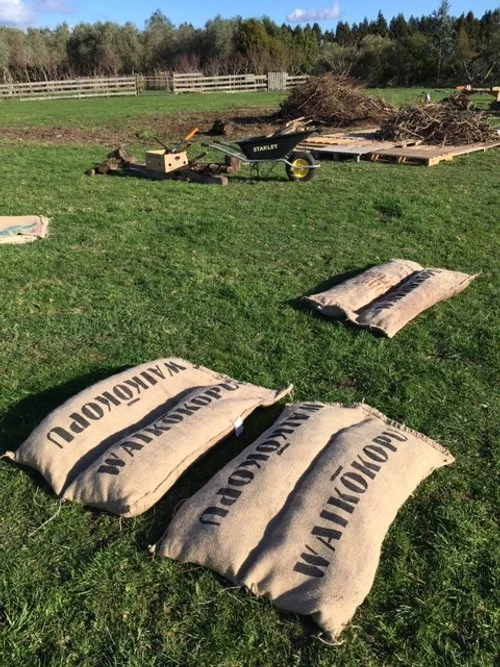Our third biochar burn with Phil… and finally getting biochar-filled sacks in Waikōkopu stream!
It was a busy few days on the farm. We burnt two full kilns of biochar and printed and sewed sacks for the Waikōkopu stream restoration project. Used coffee sacks (donated by Dark Horse Coffee in Paraparaumu) were sewn down the middle with jute thread, to create two pockets. The aim was to hold plenty of biochar in each pocket and keep the sack rigid enough that it wouldn’t slump and collapse in the flow of the stream.
The sacks were stencilled with our homemade biochar ink: biochar from the last burn at Kuku was ground by hand in a mortar and pestle, then mixed with methyl cellulose (wood fibre – basically wall paper paste but without the nasties), to create a non-toxic ink. A hand cut stencil was made, and the sacks were printed with the name of the stream; Waikōkopu. It was very reminiscent of stencilled wool bales from Huhana’s childhood farm.
Once the sacks were filled with biochar, they were blanket stitched closed. Finally, we were ready to place the sacks in the stream. We choose two strategic sites; the drain running off the paddocks and neighbouring factory/housing. And directly in the Waikōkopu stream. The sacks were held in place with olive wood stakes. When placing the sacks you have to be careful you don’t create a complete blockage, as the force of the water could wash away the sacks or cut around them, causing further erosion to the steep sides of the stream. Rather, we left small gaps in between the sacks, so that the water can still rush through and over the sacks in a heavy rain event. Hopefully this means the sacks will stay in place.
As we lowered the sacks in to the stream, the biochar text started to seep. Waikōkopu slipped off the sack and soaked back into the rushing waters.
A week later the biochar sacks were still in place in the stream, despite some heavy rain events. The text is now all but washed away – a tiny amount of non-toxic biochar has washed down stream – but the biochar-filled sacks remain. The next steps are to do water monitoring upstream and downstream, to determine the efficacy of the biochar as a filter.
There are two reasons we are putting biochar-filled sacks in this stream; we want to use the biochar to filter contaminants from the water, and we also want to create sediment traps that will slowly raise the narrow, deep bed of the stream, into a more shallow and wider stream basin. Combined with planned stream-edge planting, we are tending to this section of Waikōkopu to nurse it back to a healthy and biodiverse waterway.
The next stage of this project is to continue making biochar, loading in to sacks and placing in the stream. We will monitor how the sacks perform – have we got the right design, shape and fill of biochar? Have we placed them in the most advantageous sites? Are they staying put? Do we need better staking? As the blackberry and arum lillies are removed from the stream edges, we will be lining the stream banks with an eco-sourced weed matt and starting an appropriate stream edge planting scheme. There is the potential to make stencilled biochar drawings on the weed matt – we are looking into this now. So watch for an update later this year.
Heart-felt thanks to Dark Horse Coffee Roastery and café for donating the coffee sacks and being so supportive of our project. You are guys are awesome!
https://darkhorsecoffee.co.nz/
Massive thanks to Matthijs and Julia – we couldn’t have done it without you!
Thanks, as always, to Huhana, Richard and Tama for their manaakitanga. And Phil for his expertise and enthusiasm for this project.
Photos by Maija Stephens, documentary photographer for Te Waithui ā Nuku: Drawing Ecologies group, working alongside the Deep South National Science Challenge, Phase 3: Manaaki i ngā taonga i tukua mai e ngā tupuna: investigating action-oriented climate change transitions to water-based land uses that enhance taonga species 2020-2022.
Words by Monique Jansen












